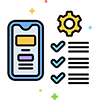Build an App without Code

Can You Build an App Without Code?
Absolutely! The amazing thing about modern technology is that you can build full-fledged apps without needing to write a single line of code. This is done through “no-code” app builders.
Breakdown – Build an App without Code
What are No-Code App Builders?
These platforms provide a visual interface where you drag-and-drop pre-built components to design your app’s appearance and functionality. It’s all about using blocks, templates, and setting rules rather than traditional programming languages. Popular use cases include creating mobile apps, websites, basic web apps, and internal business automation tools.
10 Advantages of No-Code App Development
No-code app development revolutionizes how software is built. It brings speed, cost-effectiveness, and accessibility to the process, empowering individuals and teams to create solutions without traditional coding barriers. This approach fosters innovation, agility, and a focus on core business goals.
accessibility to the process, empowering individuals and teams to create solutions without traditional coding barriers. This approach fosters innovation, agility, and a focus on core business goals.
- Speed – No-code significantly accelerates development. Instead of writing lines of code, you visually build apps, cutting development time from months to weeks or even days.
- Cost-effectiveness – by removing the need for specialized developers, no-code platforms reduce costs. This is especially helpful for startups and smaller businesses.
- Accessibility – No-code democratizes app building. People without coding backgrounds (“citizen developers”) can now create the software they need.
- Reduced Risk – with faster development and less complex processes, the risk of project failure or significant delays is lowered.
- Easy Updates and Maintenance – changes can be made quickly with visual interfaces, streamlining maintenance and enabling constant improvement.
- Agility and Flexibility – No-code allows fast response to market changes or adapting ideas based on user feedback. You can adjust your app in a highly responsive way.
- Experimentation – testing new ideas is simpler due to quick prototyping. This encourages innovation and refinement of solutions.
- Collaboration – No-code facilitates collaboration between business users and technical teams. Business users can be directly involved in shaping the app, improving alignment.
- Focus on Core Business Value – teams can devote resources to their primary area of expertise rather than spending time and effort on the underlying coding framework.
- Reduced Shadow IT – with no-code tools, IT and business departments can work together to create authorized, safe solutions, mitigating the need for risky, unapproved workarounds.
10 Disadvantages of No-Code App Development
While no-code platforms offer speed and accessibility, they also present potential drawbacks. Limitations in customization, performance, and scalability are concerns, along with vendor dependence and possible security reliance. Choosing a no-code tool requires careful consideration to ensure it aligns with your project’s specific demands and long-term growth potential.
customization, performance, and scalability are concerns, along with vendor dependence and possible security reliance. Choosing a no-code tool requires careful consideration to ensure it aligns with your project’s specific demands and long-term growth potential.
- Limited Customization – while customization options exist, no-code platforms might struggle to match the granular control of traditional coding for building truly unique, tailored features.
- Potential Performance Bottlenecks – the simplified visual methods used by no-code tools can sometimes lead to less optimized code than hand-written solutions, potentially impacting performance in highly demanding applications.
- Scalability Concerns – for rapidly growing or very complex apps, no-code platforms might present scalability challenges. You could find limitations with large databases or high user traffic volumes.
- Vendor Lock-in – your app becomes heavily tied to the capabilities and continuation of the chosen no-code platform. Migration to a different platform can be arduous or sometimes impossible.
- Lack of Control – building without direct code access reduces your direct control over finer details of the app’s underlying architecture and codebase.
- Security Considerations – you rely heavily on the vendor’s security practices. Choosing a no-code platform with a robust security track record and data management protocols is vital.
- Possible Hidden Costs – while initially more affordable, advanced features or scaling to higher usage tiers in no-code platforms can sometimes bring unforeseen cost implications.
- Learning Curve – although more accessible than traditional coding, no-code platforms have their own interface and logic systems to master.
- Integration Challenges – integrating your no-code app with specific backends, software, or unusual API systems could get complicated.
- Not Ideal for Everything – highly specialized software, custom algorithms, or cutting-edge functionality may still demand traditional development skills to implement.
10 Popular No-Code App Builders
Here is a list of 10 popular no-code app builders:
- Bubble: Powerful platform for building complex web apps, offering flexibility with design and logic customization.
- Webflow: Focuses on building visually stunning websites and web apps, ideal for designers and those wanting a high degree of polish.
- Glide: Excels at turning Google Sheets into user-friendly apps, great for quick solutions and data-driven app concepts.
- Adalo: Designed for creating native mobile apps, offering a user-friendly drag-and-drop interface and good mobile component options.
- AppSheet: Integrates well with Google Workspace, building data-driven apps from spreadsheets or pre-existing data sources.
- Airtable: Part spreadsheet, part database, Airtable’s “Blocks” feature lets you create apps built on top of your structured data.
- Thunkable: Focuses on cross-platform mobile app development (iOS and Android), featuring a drag-and-drop approach for both UI and some backend logic.
- Softr: Simplifies the process of building web applications on top of Airtable data, with an emphasis on polished user interfaces.
- Voiceflow: Specializes in creating voice-based apps for smart speakers like Alexa and Google Assistant, using a visual design approach.
- Zapier: Best known for automation, Zapier also features a visual app builder to create basic custom tools and workflows without code.
Some Basic Steps to Build an App without Code
- Define your Idea – determine exactly what kind of problem your app aims to solve. Who is your target audience?
- Choose a Platform – research and try demos to find a no-code builder that fits your needs and your experience level.
- Design the Interface – use the platform’s tools to create the look and feel of your app (screens, buttons, menus).
- Set up Logic – connect components and use the visual controls on the platform to make different buttons and interactions work.
- Incorporate Data (If needed) – connect databases or utilize the platform’s built-in storage options.
- Test and Deploy – before launch, run tests on different devices and refine the app before publishing to app stores or the web.
Conclusion – Build an App without Code
No-code app development offers a revolutionary alternative to traditional coding. It opens doors for individuals and businesses regardless of technical expertise, enabling rapid development and innovation. While flexibility and performance might have some limitations compared to traditional code, careful platform selection and a clear understanding of your project’s needs will often make no-code a wise and advantageous choice.
More Information – Build an App without Code
If you’re interested in exploring how no-code app development can transform your business, We’d love to connect! You can reach us via email at [email protected] or schedule a consultation directly below.
Let’s discuss your unique needs and how no-code can help you achieve them.
